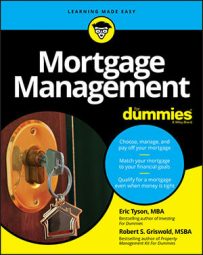There’s only one tiny problem with all that equity in your home — its utter lack of liquidity. Having equity in your house isn’t like having money in your checking account or a mutual fund you can sell any day the financial markets are open. To get your hands on your home’s equity, you must figure out a way to extract it from the property.
For instance, suppose you seek copious quantities of cash. If that’s your dilemma, you have two options. You can free up all your equity by selling your house or tap some or most of it by refinancing your mortgage with a home equity loan.
If selling is your pleasure, rush to the nearest quality bookstore for your very own copy of the latest edition of Eric and Ray Brown’s book House Selling For Dummies (Wiley).
Using home equity loans
What is a home equity loan? Home equity loans may be excellent financial tools for homeowners who want to use a relatively small amount of their equity or who don’t need all their money at once. For example, you may need $20,000 of that $150,000 equity to remodel your kitchen. Or perhaps your twins are heading to college next fall, and you’ve generously decided to pay their tuition. Folks often tap their home’s equity to buy a new car or pay off unexpected medical bills.These loans are frequently called home equity lines of credit or, given the mortgage industry’s love of acronyms, HELOCs. Home equity line of credit is an appropriate term, because this type of loan is essentially a line of credit secured by a second mortgage on a property.
How do home equity loans work, you ask? As long as you don’t exceed the maximum loan amount previously agreed to by you and the lender, you can borrow precisely as much money as you need exactly when you need it. Take all the cash in one fell swoop or dole it out as you desire. You pay interest only on the outstanding loan balance, not your total line of credit.
Watch out! Many home equity loans contain clauses giving lenders the unilateral right to cancel or suspend a line of credit. Suppose, for example, your lender thinks your home has declined in value due to a soft local real estate market. The lender can yank your line of credit. Woe be it to you if you just started to remodel your kitchen or were counting on using the equity to pay the twins’ college tuition for next fall.
The best defense is a good offense. Instead of living in fear that your lender is going to pull the HELOC partway through your project, a prudent person like you can get the money out while the getting is good. Withdraw all funds you estimate needing before starting your project or before the tuition is due. Put the money into a fully liquid interest-bearing account (such as a money market mutual fund) to partially offset your interest charges. (The gap between the interest you pay for the HELOC and interest you earn on the funds is called the opportunity cost of money.)
Equity loans are also aptly referred to as debt consolidation loans. If you’re burdened by consumer debt from unpaid credit card balances, installment loans, and personal loans — and you’re a homeowner with sufficient equity in your property — you can use a HELOC to consolidate all your high interest rate loans into one relatively lower interest and lower monthly payment loan.Considering tax consequences of home equity loans
All people are created equal. All debt isn’t. For example, the interest charged for student loans, credit card debt, and car loans is classified as consumer interest. This distinction is noteworthy because consumer interest isn’t tax deductible.Mortgage interest, on the other hand, generally is tax deductible. One of a home equity loan’s most appealing features is that the interest you pay on a HELOC may be deductible for both federal and state income tax purposes. Whether the interest actually is deductible depends on three IRS tests:
- The $100,000 test: There’s a $100,000 limit on tax deductibility of home equity indebtedness. You won’t go to jail or lose all your hair if your HELOC exceeds $100,000. The amount could be $10 million, and your kindly old Uncle Sam wouldn’t care. Any interest charged on the portion of your equity loan in excess of $100,000, however, will be classified as consumer interest, which isn’t tax deductible.
- Capital improvements test: Home equity loan interest is only supposed to be deductible to the extent that the proceeds from such loans are used for capital improvements to your home.
- The market value test: The IRS says that deductible home equity indebtedness can’t exceed the fair market value of your home. For now, be advised that interest charged for any amount you borrow in excess of your home’s current value is not tax deductible.

